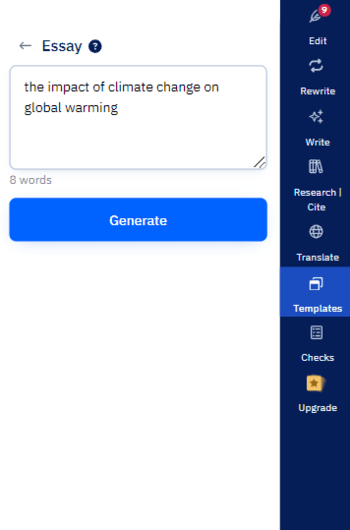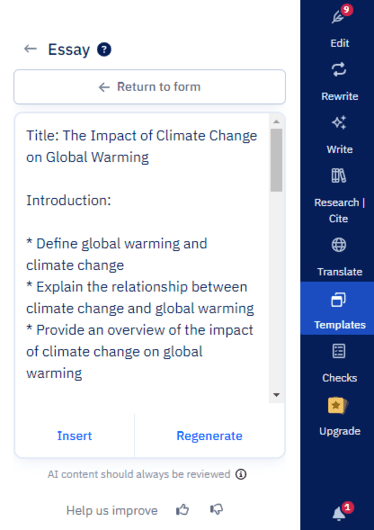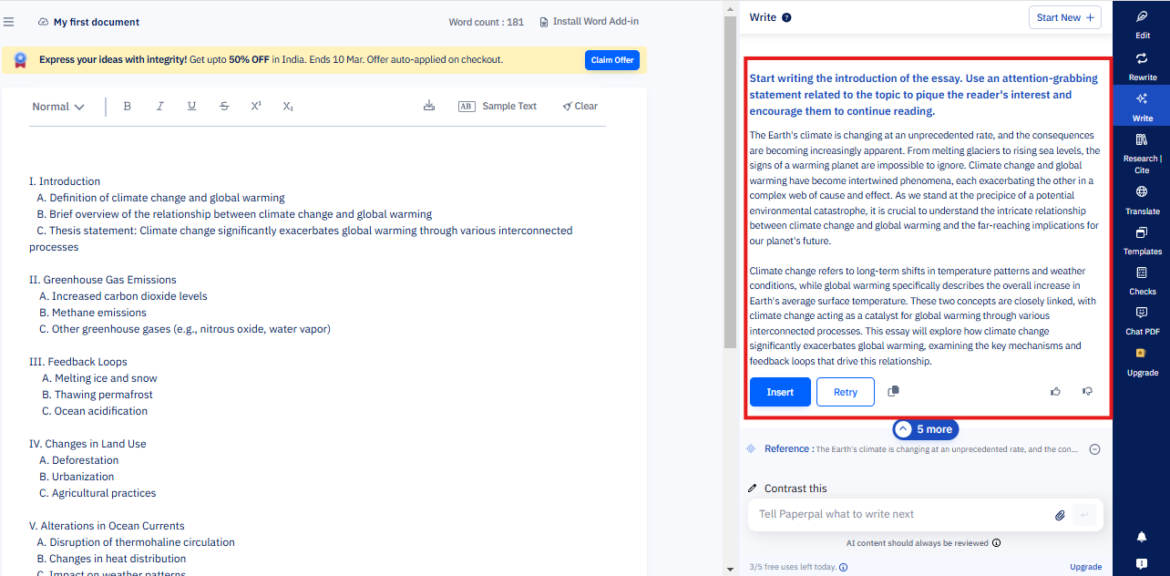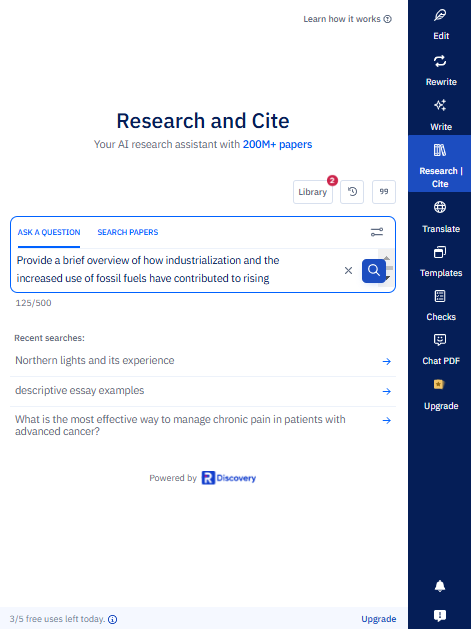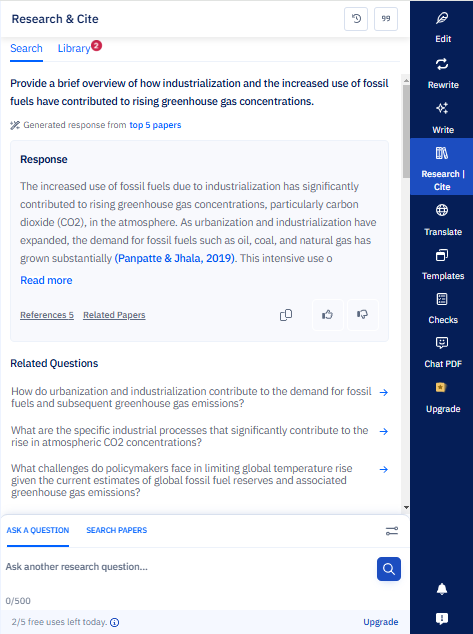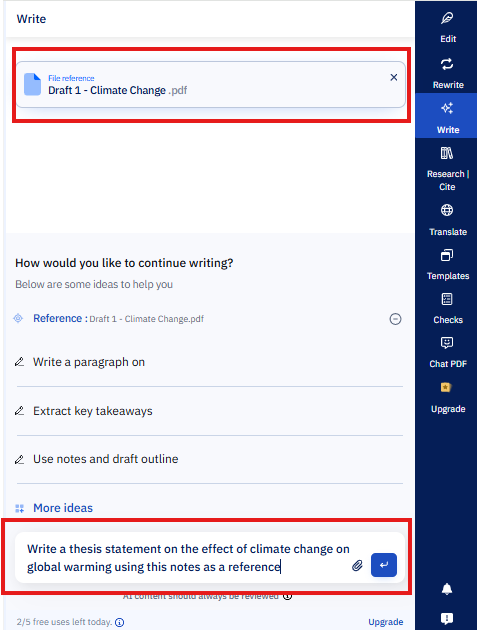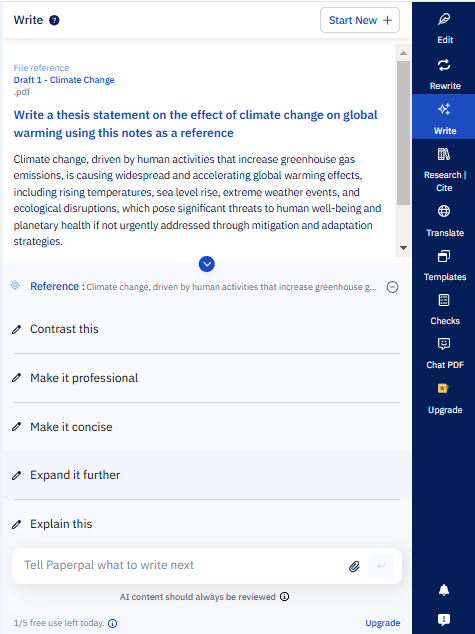Table of Contents
The introduction of an essay plays a critical role in engaging the reader and providing contextual information about the topic. It sets the stage for the rest of the essay, establishes the tone and style, and motivates the reader to continue reading. Before we get into how to make introduction in research, we need to know how it is structured. The structure of an essay is crucial for organizing your thoughts and presenting them clearly and logically. It is divided as follows:2
- Introduction: The introduction should grab the reader’s attention with a hook, provide context, and include a thesis statement that presents the main argument or purpose of the essay.
- Body: The body should consist of focused paragraphs that support your thesis statement using evidence and analysis. Each paragraph should concentrate on a single central idea or argument and provide evidence, examples, or analysis to back it up.
- Conclusion: The conclusion should summarize the main points and restate the thesis differently. End with a final statement that leaves a lasting impression on the reader. Avoid new information or arguments.
What is an essay introduction?
An introduction is the opening section of an essay, paper, or other written work. It introduces the topic and provides background information, context, and an overview of what the reader can expect from the rest of the work.1 The key is to be concise and to the point, providing enough information to engage the reader without delving into excessive detail. If you’re looking for an example of introduction in research, you’ll find it typically includes a hook, background, and a clear thesis. For a more structured approach, reviewing an introduction in research example can be helpful for clarity.
What to include in an essay introduction?
The essay introduction is crucial as it sets the tone for the entire piece and provides the reader with a roadmap of what to expect. Here are key elements to include in your essay introduction:
- Hook: Start with an attention-grabbing statement or question to engage the reader. This could be a surprising fact, a relevant quote, or a compelling anecdote.
- Background information: Provide context and background information to help the reader understand the topic. This can include historical information, definitions of key terms, or an overview of the current state of affairs related to your topic.
- Thesis statement: Clearly state your main argument or position on the topic. Your thesis should be concise and specific, providing a clear direction for your essay.
How to Write an Essay Introduction with Paperpal?
Step 1: Build an Outline
Creating a strong essay introduction is crucial, and using an outline as a base can significantly streamline the process. An essay introduction outline can organize your thoughts and ensure the introduction stays focused on the main argument of your essay. This prevents you from going off on tangents or including irrelevant information. To build an outline, you can use Paperpal’s AI Writing Templates to provide a base for your essay introduction. Here’s how you can generate an essay introduction outline with Paperpal.
- Go to Templates > Outlines > Essays
- Enter your Topic
- Generate an Essay Outline
Step 2: Start with a Hook
Okay, now you’re ready with the outline. You know you need a great introduction, something that grabs your reader, but… where do you even start? Begin your introduction paragraph with an attention-grabbing statement, question, quote, or anecdote related to your topic. The hook should pique the reader’s interest and encourage them to continue reading.
That’s where Paperpal Write comes in. It’s like having a writing buddy who knows exactly how to start an essay. Here’s how easy it is:
- Just add your outline or upload your notes into Paperpal.
- Tell Paperpal, “Hey, write me a catchy intro hook.” You can even say, “Use these points from my notes!” Boom! In seconds, you’ll have a solid introduction hook.
And if you want to tweak it? No problem. Paperpal gives you easy options to change it up, or you can just tell it exactly what you want.
Step 3: Provide Background Information
Background information establishes the context within which your argument exists. It brings the reader up to speed, ensuring they have the necessary foundation to comprehend your thesis. The background of an essay introduction can include defining key terms, providing historical context and scientific consensus or outlining relevant theories.
If you want to explain where an idea came from, or explain the science behind it in your essay introduction, Paperpal’s Research feature can help. Just ask a research question and Paperpal finds the papers from a database of 250M+ research articles that answer your question. It also gives you a quick summary of all the papers right there, so you don’t have to wade through tons of complicated articles.
Step 4: State Your Thesis Statement
The ending of your essay introduction presents the main argument of your essay, also known as Thesis Statement. A thesis statement is generally placed at the end of the essay introduction .
While the essay introduction can gradually lead the reader from a general topic to the specific argument of your essay. Placing the thesis statement at the end helps to create a smooth and logical progression. The thesis statement acts as a roadmap, guiding both the writer and the reader through the essay’s main points. It signals the direction the essay will take and the evidence that will be presented.
Got some notes jotted down? Great! You can actually upload them to Paperpal and ask it to write your thesis statement for you. Just tell Paperpal what you need, or pick from some of its pre-made options, and it’ll create a thesis statement for you.
Then, you can make it your own! Change the wording, adjust it until it sounds exactly right. Or, if you have a very specific idea, you can give Paperpal your own instructions to get exactly what you want for your essay’s introduction. It’s all about making writing that thesis statement easier and faster.
Once you’re done with the essay introduction, preview the main points and align how you want the reader comprehend the thesis statement. o expect and how you will support your thesis. Keep it concise and clear. Avoid going into too much detail or including information not directly relevant to your topic. Revise and personalize your essay introduction after you’ve written the rest of your essay to ensure it aligns with your final argument.
How to write a hook for your essay?
This is one of the key steps in how to write an essay introduction. Crafting a compelling hook is vital because it sets the tone for your entire essay and determines whether your readers will stay interested. A good hook draws the reader in and sets the stage for the rest of your essay.
- Avoid Dry Facts: Instead of simply stating a bland fact, try to make it engaging and relevant to your topic. For example, if you’re writing about the benefits of exercise, you could start with a startling statistic like, “Did you know that regular exercise can increase your lifespan by up to seven years?”
- Avoid Using a Dictionary Definition: While definitions can be informative, they’re not always the most captivating way to start an essay. Instead, try to use a quote, anecdote, or provocative question to pique the reader’s interest. For instance, if you’re writing about freedom, you could begin with a quote from a famous freedom fighter or philosopher.
- Do Not Just State a Fact That the Reader Already Knows: This ties back to the first point—your hook should surprise or intrigue the reader. Here’s an essay introduction paragraph example, if you’re writing about climate change, you could start with a thought-provoking statement like, “Despite overwhelming evidence, many people still refuse to believe in the reality of climate change.”
How to include background information?
Including background information in the introduction section of your essay is important to provide context and establish the relevance of your topic. When writing the background information, you can follow these steps:
- Start with a General Statement: Begin with a general statement about the topic and gradually narrow it down to your specific focus. For example, when discussing the impact of social media, you can begin by making a broad statement about social media and its widespread use in today’s society, as follows: “Social media has become an integral part of modern life, with billions of users worldwide.”
- Define Key Terms: Define any key terms or concepts that may be unfamiliar to your readers but are essential for understanding your argument.
- Provide Relevant Statistics: Use statistics or facts to highlight the significance of the issue you’re discussing. For instance, “According to a report by Statista, the number of social media users is expected to reach 4.41 billion by 2025.”
- Discuss the Evolution: Mention previous research or studies that have been conducted on the topic, especially those that are relevant to your argument. Mention key milestones or developments that have shaped its current impact. You can also outline some of the major effects of social media. For example, you can briefly describe how social media has evolved, including positives such as increased connectivity and issues like cyberbullying and privacy concerns.
- Transition to Your Thesis: Use the background information to lead into your thesis statement, which should clearly state the main argument or purpose of your essay. For example, “Given its pervasive influence, it is crucial to examine the impact of social media on mental health.”
How to write a thesis statement?
A thesis statement is a concise summary of the main point or claim of an essay, research paper, or other type of academic writing. It appears near the end of the introduction. Here’s how to write a thesis statement:
- Identify the topic: Start by identifying the topic of your essay. For example, if your essay is about the importance of exercise for overall health, your topic is “exercise.”
- State your position: Next, state your position or claim about the topic. This is the main argument or point you want to make. For example, if you believe that regular exercise is crucial for maintaining good health, your position could be: “Regular exercise is essential for maintaining good health.”
- Support your position: Provide a brief overview of the reasons or evidence that support your position. These will be the main points of your essay. For example, if you’re writing an essay about the importance of exercise, you could mention the physical health benefits, mental health benefits, and the role of exercise in disease prevention.
- Make it specific: Ensure your thesis statement clearly states what you will discuss in your essay. For example, instead of saying, “Exercise is good for you,” you could say, “Regular exercise, including cardiovascular and strength training, can improve overall health and reduce the risk of chronic diseases.”
Examples of essay introduction
Here are examples of essay introductions for different types of essays:
Argumentative Essay Introduction Example:
Topic: Should the voting age be lowered to 16?
“The question of whether the voting age should be lowered to 16 has sparked nationwide debate. While some argue that 16-year-olds lack the requisite maturity and knowledge to make informed decisions, others argue that doing so would imbue young people with agency and give them a voice in shaping their future.”
Expository Essay Introduction Example
Topic: The benefits of regular exercise
“In today’s fast-paced world, the importance of regular exercise cannot be overstated. From improving physical health to boosting mental well-being, the benefits of exercise are numerous and far-reaching. This essay will examine the various advantages of regular exercise and provide tips on incorporating it into your daily routine.”
Literary Analysis Essay Introduction Example
Text: “To Kill a Mockingbird” by Harper Lee
“Harper Lee’s novel, ‘To Kill a Mockingbird,’ is a timeless classic that explores themes of racism, injustice, and morality in the American South. Through the eyes of young Scout Finch, the reader is taken on a journey that challenges societal norms and forces characters to confront their prejudices. This essay will analyze the novel’s use of symbolism, character development, and narrative structure to uncover its deeper meaning and relevance to contemporary society.”
You can use these as a how to start an essay example reference to structure your own.
Check and revise – Checklist for essay introduction
- Engaging and Relevant First Sentence: The opening sentence captures the reader’s attention and relates directly to the topic.
- Background Information: Enough background information is introduced to provide context for the thesis statement.
- Definition of Important Terms: Key terms or concepts that might be unfamiliar to the audience or are central to the argument are defined.
- Clear Thesis Statement: The thesis statement presents the main point or argument of the essay.
- Relevance to Main Body: Everything in the introduction directly relates to and sets up the discussion in the main body of the essay.
Key takeaways
Writing a strong introduction is crucial for setting the tone and context of your essay. Here are the key takeaways for how to write essay introduction:3
- Hook the Reader: Start with an engaging hook to grab the reader’s attention. This could be a compelling question, a surprising fact, a relevant quote, or an anecdote.
- Provide Background: Give a brief overview of the topic, setting the context and stage for the discussion.
- Thesis Statement: State your thesis, which is the main argument or point of your essay. It should be concise, clear, and specific.
- Preview the Structure: Outline the main points or arguments to help the reader understand the organization of your essay.
- Keep it Concise: Avoid including unnecessary details or information not directly related to your thesis.
- Revise and Edit: Revise your introduction to ensure clarity, coherence, and relevance. Check for grammar and spelling errors.
- Seek Feedback: Get feedback from peers or instructors to improve your introduction further.
Frequently Asked Questions:
An essay intro is generally concise and personal – it uses a hook and thesis to present your unique perspective or argument. In contrast, a research paper introduction is more formal and structured: alongside the hook and thesis, it provides detailed background, context, and highlights sources or literature to frame the contribution A strong thesis statement clearly presents your main argument in one concise sentence, usually at the end of your introduction. Start by answering a key question about your topic, then refine it to explain your stance and briefly mention supporting points. It should be specific, debatable, and guide the direction of your essay. Tailor your tone, language, and context to suit your readers’ background and expectations — academic papers often demand formal, objective language, while a blog or magazine essay might allow a conversational, engaging style. Adjust the hook and background details based on what your audience already knows or cares about. For instance, with a specialist audience, dive into technical terms quickly; with a general audience, start broader and define key ideas plainly. This ensures your introduction connects and resonates appropriately . Persuasive essays start with a clear stance and supporting points. Narrative essays open with a personal story or vivid scene to draw the reader in. Analytical essays introduce the subject (like a book or film) and present a thesis about its meaning or structure. Each type sets the stage differently to match its purpose. Clichés—like “throughout history” or “as we all know” make writing seem lazy, vague, and unoriginal. Avoid them by using specific, fresh language that reflects your unique perspective. Prefer short, active words over long, passive ones, and trim unnecessary wording. Read your intro aloud: if you finish someone else's thought, that’s a cliché—rework it to say something only you can say. The purpose of an essay introduction is to give an overview of the topic, context, and main ideas of the essay. It is meant to engage the reader, establish the tone for the rest of the essay, and introduce the thesis statement or central argument. An essay introduction typically ranges from 5-10% of the total word count. For example, in a 1,000-word essay, the introduction would be roughly 50-100 words. However, the length can vary depending on the complexity of the topic and the overall length of the essay. An essay introduction is critical in engaging the reader and providing contextual information about the topic. To ensure its effectiveness, consider incorporating these key elements: a compelling hook, background information, a clear thesis statement, an outline of the essay's scope, a smooth transition to the body, and optional signposting sentences. The process of writing an essay introduction is not necessarily straightforward, but there are several strategies that can be employed to achieve this end. When experiencing difficulty initiating the process, consider the following techniques: begin with an anecdote, a quotation, an image, a question, or a startling fact to pique the reader's interest. It may also be helpful to consider the five W's of journalism: who, what, when, where, why, and how. Crafting a compelling thesis statement for your introduction paragraph is crucial to grab your reader's attention. To achieve this, avoid using overused phrases such as "In this paper, I will write about" or "I will focus on" as they lack originality. Instead, strive to engage your reader by substantiating your stance or proposition with a "so what" clause. While writing your thesis statement, aim to be precise, succinct, and clear in conveying your main argument. To create an effective essay introduction, ensure it is clear, engaging, relevant, and contains a concise thesis statement. It should transition smoothly into the essay and be long enough to cover necessary points but not become overwhelming. Seek feedback from peers or instructors to assess its effectiveness.
How does an essay introduction differ from a research paper introduction?
How do I write a strong thesis statement for my essay introduction
How can I adapt my essay introduction to different audiences?
What are examples of introductions for different types of essays (e.g., persuasive, narrative, analytical)?
How can I avoid clichés or overused phrases in my essay introduction?
What is the purpose of an essay introduction?
How long should an essay introduction be?
What elements should be included in an essay introduction?
What are some strategies for starting an essay introduction?
For instance, an anecdotal opening could be structured as follows: "As I ascended the stage, momentarily blinded by the intense lights, I could sense the weight of a hundred eyes upon me, anticipating my next move. The topic of discussion was climate change, a subject I was passionate about, and it was my first public speaking event. Little did I know, that pivotal moment would not only alter my perspective but also chart my life's course." How do you write a thesis statement in an essay introduction?
How do I know if my essay introduction is effective?
References
- Cui, L. (2022). Unit 6 Essay Introduction. Building Academic Writing Skills.
- West, H., Malcolm, G., Keywood, S., & Hill, J. (2019). Writing a successful essay. Journal of Geography in Higher Education, 43(4), 609-617.
- Beavers, M. E., Thoune, D. L., & McBeth, M. (2023). Bibliographic Essay: Reading, Researching, Teaching, and Writing with Hooks: A Queer Literacy Sponsorship. College English, 85(3), 230-242.
Paperpal is a comprehensive AI writing toolkit that helps students and researchers achieve 2x the writing in half the time. It leverages 21+ years of STM experience and insights from millions of research articles to provide in-depth academic writing, language editing, and submission readiness support to help you write better, faster.
Get accurate academic translations, rewriting support, grammar checks, vocabulary suggestions, and generative AI assistance that delivers human precision at machine speed. Try for free or upgrade to Paperpal Prime starting at US$25 a month to access premium features, including consistency, plagiarism, and 30+ submission readiness checks to help you succeed.
Experience the future of academic writing – Sign up to Paperpal and start writing for free!




